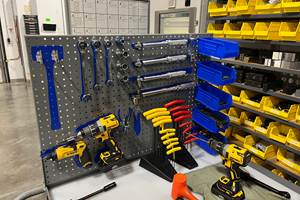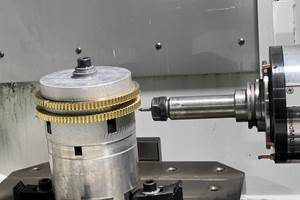The Tax-Smart Way To Educate Your Kids/Grandkids
The cost of sending your kids or grand- kids to college has skyrocketed. And predictions are that college costs will continue to rise each year in the foreseeable future.
Share


.png;maxWidth=45)
DMG MORI - Cincinnati
Featured Content
View More
Autodesk, Inc.
Featured Content
View More


ECi Software Solutions, Inc.
Featured Content
View More



Takumi USA
Featured Content
View More
Hwacheon Machinery America, Inc.
Featured Content
View MoreThe cost of sending your kids or grand- kids to college has skyrocketed. And predictions are that college costs will continue to rise each year in the foreseeable future.
Sorry, but the cost of educating your younger family members is simply not deductible. But wait. There is another way. Here’s a real life example. Only the names have been changed. Joe and Mary have three grandchildren, Tad, Tillie and Tom. Tad is 2 years old, Tillie 5 and Tom 7.
Joe called our office and asked us to design his estate plan and business succession plan. As is our custom we asked Joe and Mary to give us their goals for themselves, their business and their family. One of their family goals—to provide for their grandchildren’s college education, put a down payment on a house and provide for their retirement—is the subject of this article.
Let’s use the plan (called a private retirement plan—PR Plan) created for Tad as an example. Joe and Mary created a trust with Tad as the beneficiary. The trust was tailored to accomplish three specific objectives: (1) pay $12,000 per year for four years of college; (2) pay $50,000 as a down payment on a house at age 32; and (3) pay $150,000 a year for retirement starting at age 60 and payable to age 95. To fund the entire plan Joe and Mary will make a gift to the trust of $7,000 a year for eight years (a total of $56,000). It should be noted that a PR Plan is very flexible and that all of the dollar figures and payment ages in Tad’s plan can be higher or lower.
The trust will purchase a high-cash surrender value (CSV) life insurance policy on Tad’s life and use the annual $7,000 gift to pay the premiums for eight years. The CSV will compound tax free for as long as Tad lives or until age 95. When the time comes to draw money from the trust (to accomplish the plan objectives), a loan will be made against the CSV. Loans are tax-free under the law. Someday when Tad dies, the proceeds of the policy will pay back the loans used to meet the three objectives—education, house down payment and retirement payments—of the PR Plan.
Where does all the money come from to meet the costly objectives? . . . The answer is the compounding of those $7,000 premium payments over time in a tax-free insurance environment. You are about to be astounded by the estimated total benefits that will be paid under Tad’s plan. If he lives to age 70, $4.6 million; age 80, $6.1 million and age 95, $8.1 million.
The PR Plans for Tillie and Tom are identical to Tad’s plan, and the total benefits are about the same. For Tillie (age 5) the $7,000 premiums must be paid for ten years and for Tom (age 7) the $7,000 premiums must be paid for 14 years. For a newborn baby it only takes $7,000 for seven years to duplicate Tad’s PR Plan. For a 30-year-old it will take 17 years of $7,000 annual premium payments to provide $150,000 annual retirement payment starting at age 60 (and continuing to age 95)—still a spectacular economic and tax result.
To Avoid The Business Expense Trap
Do you own or work for a closely held corporation and travel on company business? Entertain? Use your auto? Incur other business expenses? Then your company’s policy—because of custom or a written plan—should be to reimburse your employees dollar for dollar for all business expenses incurred in the course of employment, a practical and common practice. And, assuming all expenses are properly substantiated, the perfect tax-safe course to follow.
But since you own the company, the reimbursement seems like you’re paying yourself. So you foot the company expenses out of your pocket, figuring you’ll deduct those expenses on your personal tax return. Unfortunately, this practice can be a costly tax trap.
Even though your business logic may seem sound, according to an important Tax Court case (Cavitt, TC Memo 1990-366), your personal deduction for normally valid business expenses is simply not allowed. Ouch! Here’s the sad story. An employee claimed deductions for legitimate meals and lodging expenses that his employer would have reimbursed if asked. Thumbs down, ruled the court. Why? Even though the expenses were entitled to be deducted (by the employer), the fact that the employee chose to pay them out of his own pocket was unnecessary. The law is this area in clear—only ordinary and necessary expenses are deductible.
What should you do? Always—absolutely always, for every single business expense item that is deductible—take the reimbursement from your company. How often should you submit your request for reimbursement? Weekly, monthly, even quarterly is okay. What’s most important is to get the reimbursement on a regular and consistent basis. That way, your company is assured of its deduction. Best of all, the reimbursement is tax-free to you.
Related Content
Lean Approach to Automated Machine Tending Delivers Quicker Paths to Success
Almost any shop can automate at least some of its production, even in low-volume, high-mix applications. The key to getting started is finding the simplest solutions that fit your requirements. It helps to work with an automation partner that understands your needs.
Read MoreHow to Accelerate Robotic Deburring & Automated Material Removal
Pairing automation with air-driven motors that push cutting tool speeds up to 65,000 RPM with no duty cycle can dramatically improve throughput and improve finishing.
Read MoreTranslating a Prototyping Mindset to Production
The experimental mindset that benefited BDE Manufacturing Technologies as a prototype job shop has given it an adaptable edge as a production facility.
Read MoreFour-Axis Horizontal Machining Doubles Shop’s Productivity
Horizontal four-axis machining enabled McKenzie CNC to cut operations and cycle times for its high-mix, high-repeat work — more than doubling its throughput.
Read MoreRead Next
Building Out a Foundation for Student Machinists
Autodesk and Haas have teamed up to produce an introductory course for students that covers the basics of CAD, CAM and CNC while providing them with a portfolio part.
Read MoreRegistration Now Open for the Precision Machining Technology Show (PMTS) 2025
The precision machining industry’s premier event returns to Cleveland, OH, April 1-3.
Read More5 Rules of Thumb for Buying CNC Machine Tools
Use these tips to carefully plan your machine tool purchases and to avoid regretting your decision later.
Read More

























.jpg;maxWidth=300;quality=90)















